Protecting your online business starts with knowing your rights. For instance, without an intellectual property disclaimer, you’re putting your content at risk of unauthorized use.
An intellectual property disclaimer is a legal statement that clarifies the rights you reserve over the original content you’ve created.
This type of disclaimer explicitly states the ownership and limitations on the use of your intellectual assets. By doing so, it also delineates the scope of rights held by others, particularly in how they may or may not use your copyrighted work.
So, how do you use it to protect your business? That’s what we’ll talk about below.
- An intellectual property disclaimer protects your original content and online assets. Define ownership, limitations on use, and how you’ll enforce your rights.
- Place it strategically on your website, such as in the footer, Terms and Conditions page, or individual pages.
- You can use a disclaimer template or generator to create your intellectual property disclaimer. Adapt it to fit your business, but always prioritize clarity and comprehensiveness.
Table of Contents
PRO TIP: Take the hassle of writing your own disclaimer away with our disclaimer generator trusted by over 200,000 businesses. It’ll save you hours of work and possible costly legal mistakes.
Who Needs an Intellectual Property Disclaimer?
Virtually any entity creating and sharing content online needs an intellectual property rights disclaimer to ensure their creative and digital assets are protected by copyright laws. Some examples include:
Online Content Creators
If you’re a social media influencer, you’re constantly creating content that could easily be copied or shared without permission. Since it lets you define how others can use your work, an intellectual property disclaimer is your best friend here.
With one, you get to protect your creative output under copyright laws while you share your insights and stories with the world.
E-commerce Stores
Running an online store? Every product description, image, and unique design you create can be key to your brand’s identity and success.
An intellectual property disclaimer guarantees your original content stays just that—original. It sets clear boundaries on how others can use your materials, helping protect your hard work from being misused or copied without your consent.
Software Developers
Crafting code is an art, and your innovations deserve protection. An intellectual property disclaimer safeguards your applications, ensuring your hard work isn’t redistributed or tampered with without your approval.
Educational Institutions and e-Learning Platforms
Do you manage or create content for educational institutions or e-learning platforms? Your courses and educational materials are valuable intellectual properties.
Having a disclaimer helps preserve the integrity of your offerings. It’s essential for maintaining the educational quality and originality you’ve worked hard to establish.
Digital Art and Photography Websites
For digital artists or photographers showcasing their work online, their unique creations are their signature. This is why an intellectual property disclaimer is a must.
Such a disclaimer spells out how others can interact with their work. In turn, they can share their vision with the world while keeping their rights secure.
Why Do You Need an Intellectual Property Disclaimer for Your Website?
You need an intellectual property disclaimer to state the intellectual property rights reserved for the ownership of your work and the terms of its use to prevent copyright infringement. This way, you communicate and legally uphold your proprietary rights.
That said, it’s important to note that an intellectual property disclaimer is broader than a copyright disclaimer.
The former covers all forms of intellectual property, including patents, trademarks, and trade secrets. In comparison, you would use a copyright disclaimer specifically to address the copyright aspect of your creations.
While both types of disclaimers protect ownership of your work, an intellectual property disclaimer is essential for comprehensive protection.
If your website features various types of intellectual property, you might need a copyright disclaimer, too. However, it should be part of a larger strategy that includes a more comprehensive intellectual property disclaimer.
10 Key Components of an Intellectual Property Disclaimer
Understanding the components of a copyright disclaimer and other intellectual property disclaimers will help you safeguard your work against misuse. Here’s what to include to ensure your creations are protected across all fronts:
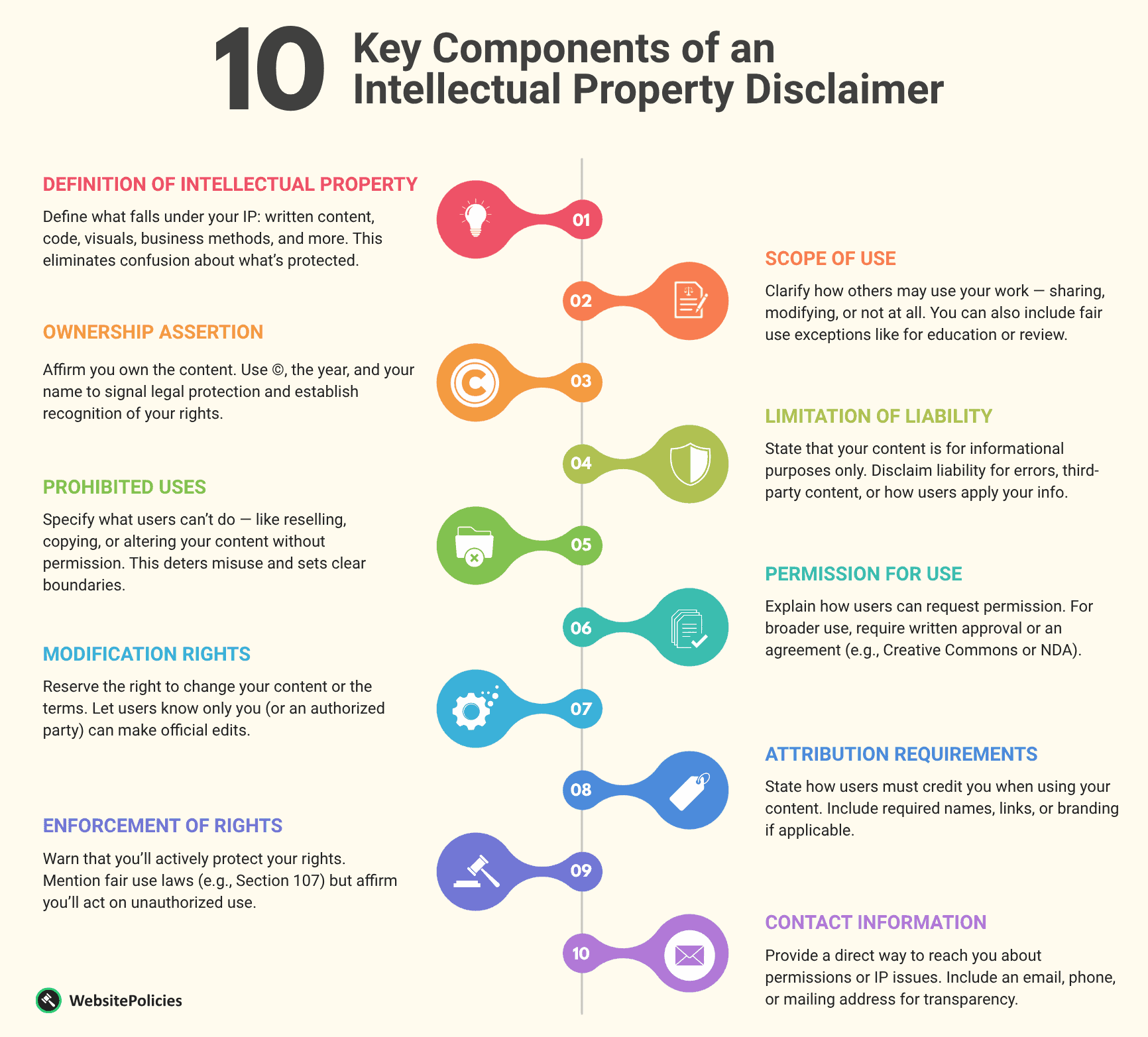
1. Definition of Intellectual Property
This first step is about making sure everyone is on the same page. Basically, it is where you lay the groundwork for understanding exactly what falls under the protection of your disclaimer.
Here, you specify what constitutes intellectual property for your particular content or creations. This could be anything from written articles and blogs to software, graphics, and even unique business methods.
PRO TIP: When you choose to include a detailed definition of intellectual property, there will be no confusion about what is protected under the law. This helps prevent potential disputes.
2. Scope of Use
This component of an intellectual property disclaimer statement defines the boundaries within which others can use your content. This is where you say whether your work can be shared, modified, or used commercially.
Including this in your disclaimer acts not just as a copyright notice but also as a safeguard that’s comprehensive enough to protect your content without overly restricting its legitimate use.
For example, incorporating a fair use disclaimer can clarify situations where fair use of intellectual property is permissible, such as for educational or review purposes.
This balance protects your rights while respecting users’ legal allowances, creating a clear framework for how your intellectual property can be used by others respectfully and legally.
3. Ownership Assertion
This part is where you explicitly state your claim as the copyright owner. To do this, you can add a copyright symbol ©, followed by the year of first publication and the name of the copyright owner.
Take a look at Pahoti Wellness’ disclaimer to see what that can look like:
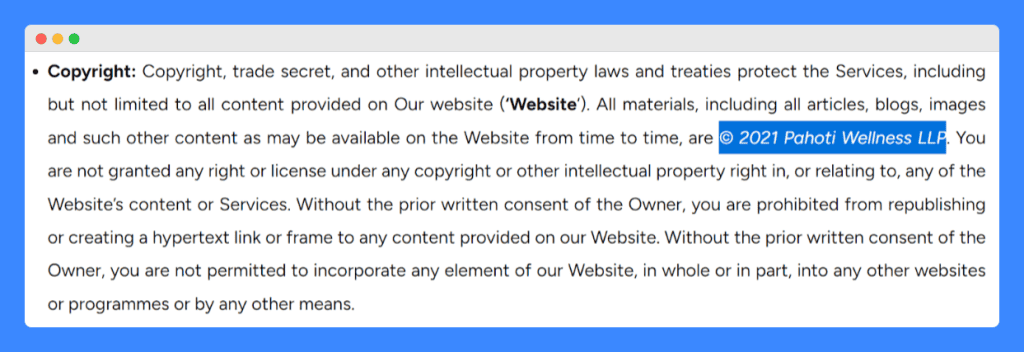
This simple step powerfully affirms your legal ownership and serves as a clear indicator of your rights. It helps users recognize your copyright immediately upon viewing your content.
When users see this, they not only understand who owns the work but also acknowledge and agree to be bound by the terms you’ve set forth regarding the use of your intellectual property.
This acknowledgment is a fundamental legal safeguard that strengthens your position against unauthorized use and potential copyright infringement.
4. Limitation of Liability
This clause typically states you are not liable for damage of any kind that may result from using your site or its content.
This includes specifying that you do not guarantee the fitness for a particular purpose of the information provided, which can be critical if someone relies on your content for specific decisions or actions.
Including this component is crucial as it also covers instances involving third-party content that might appear on your site, whether through links, guest posts, or embedded media.
PRO TIP: Add a for informational purposes only disclaimer to clarify that content is not legal or professional advice. This protects you legally and sets clear user expectations.
5. Prohibited Uses
This section of your disclaimer is where you lay down the law and outline what users cannot do with your content. Specifying the rights you retain over your content helps prevent misuse and unauthorized modifications.
Online content may be easily accessible and susceptible to misuse. But when you clearly define prohibited actions (unauthorized selling, redistribution, or creation of derivative works), you safeguard your intellectual property from potential exploitation.
Here’s how Geneva Lab put that into words in its Terms of Use:
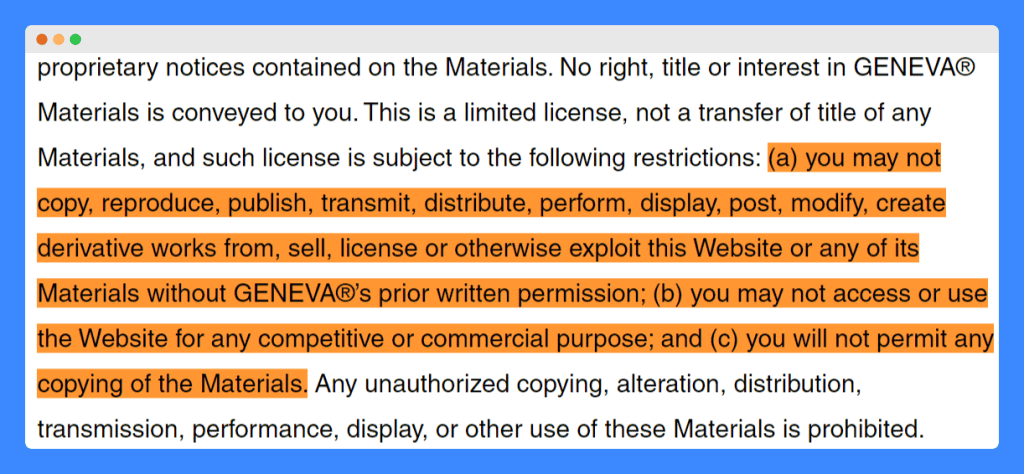
This clear communication not only helps enforce the store’s legal rights but also educates users on the boundaries of fair use.
6. Permission for Use
This section details how users can legally use copyrighted content or materials from your site.
It explains the process for obtaining express permission—often requiring written permission—to go beyond the general usage outlined in your intellectual property disclaimer.
It also specifies what is allowed under certain licenses, such as Creative Commons, and may include stipulations like signing an intellectual property non-disclosure agreement for more sensitive content.
This clarity ensures users adhere to your terms and conditions, including but not limited to permissible and prohibited scenarios you’ve outlined.
PRO TIP: Always require written agreements for extensive use to protect your content. Detail the scope of permissible use to avoid legal issues.
7. Modification Rights
Here is where you specify who has the authority to alter your content and under what circumstances. It lets users know that any modifications to your intellectual property, whether updates or corrections are made only with proper oversight.
Adding this section prevents unauthorized alterations that could misrepresent your original content or harm your brand. This component often includes a clause that you may update or modify the terms without prior notice.
8. Attribution Requirements
When it comes to others’ use of copyrighted materials, your disclaimer should outline how and when users must credit you.
Whether they redistribute, modify, or otherwise use your work, proper attribution must be given as specified. This shows respect and acknowledgment of the rights of any person who created or owns content, in line with internal copyright laws.
For example, Google says this about the use of its Cloud Translation API:

The document outlines how websites should name the Cloud Translation API, adopt specific branding elements, and display translation results if they wish to use the API.
9. Enforcement of Rights
Through this section of your disclaimer, you clarify that the content owner (you) reserves the right to enforce their intellectual property against unauthorized use. This includes taking legal action in accordance with copyright laws and regulations, as well as other applicable laws to protect their work.
Essentially, it serves as a warning that the owner is proactive about defending their rights. It references the copyright disclaimer under Section 107 of the Copyright Act.
This addresses fair use considerations and highlights the owner’s commitment to upholding not only their rights but also respecting the intellectual property rights of others.
10. Contact Information
This section provides the necessary details for users to reach out if they have questions or need permissions related to your content. It typically includes an email address, phone number, or even a physical mailing address.
Here’s an excellent example from Lockheed Martin Corporation:

Having this information readily available makes it effortless for Lockheed Martin Corporation and its users to communicate. This way, they can address any inquiries or issues regarding intellectual property directly and efficiently.
How Do You Write an Intellectual Property Disclaimer for Your Business?
A disclaimer helps to protect intellectual property. Here’s a step-by-step guide to help you create an effective one tailored to your business’s unique needs.
Step 1: Identify Your Intellectual Property
Start by identifying all the types of content you produce that need protection, such as articles, images, software, and designs. Knowing what needs protection will guide the structure of your disclaimer.
Step 2: Define the Scope of Use
Clarify what users can and cannot do with your intellectual property. This includes whether they can reproduce, modify, or distribute your content and under what conditions.
Step 3: Assert Ownership
Include a statement that asserts your ownership of the content. Use a simple copyright disclaimer to reinforce this, typically involving the copyright symbol, the year of creation, and your name or business name.
Step 4: Detail Prohibited Uses
Specify any restrictions on how your content cannot be used. This helps prevent misuse and ensures users understand their boundaries.
Step 5: Set Permissions
Outline how users can obtain permission to use your content beyond the scope outlined. Include details on whom they should contact and any conditions or fees that may apply.
Step 6: Include Attribution Requirements
Specify how and when users must credit you or your business when using your intellectual property. This includes any specific wording or links they must use.
Step 7: State Limitations of Liability
Clarify that you are not liable for how users might use your content and any consequences of that use. This protects you from legal actions related to misuse of your content.
Step 8: Outline Enforcement Measures
Explain how you will enforce your rights and the actions you will take against unauthorized use or infringement.
Step 9: Provide Contact Information
Lastly, make sure users know how to reach you if they have questions about your intellectual property rights or need to request permissions.
PRO TIP: Consider using an intellectual property disclaimer generator to simplify the process. These tools can help your disclaimer cover all legal bases and tailor it to your specific business needs.
Where To Display an Intellectual Property Disclaimer
Display your intellectual property disclaimer where it can be easily accessed before users interact with your content. For example, consider including a disclaimer in the following strategic locations:
- Website Footer: A common practice is to put a copyright notice in the website footer, where it can be seen on every page.
- Terms and Conditions Page: Integrating the disclaimer with other legal information in the Terms and Conditions ensures that users are aware of their rights and responsibilities.
- About Us Page: When you display a copyright disclaimer on this page, you provide context for your intellectual property policies alongside your business’s backstory.
- Download or Signup Pages: If your site involves downloads or user registrations, this is a crucial spot to copy and paste a copyright disclaimer so users agree to your terms before using your services.
- Contact Page: While less common, adding a disclaimer on this page can remind users of intellectual property rules before they reach out for permissions or partnerships.
Intellectual Property Disclaimer Examples You Can Learn From
Want to see how other businesses protect their intellectual property? Take a look at these intellectual property and copyright disclaimer examples:
1. The BFH Garage
The BFH Garage is a YouTube channel known for its in-depth automotive repair tutorials, custom builds, and reviews of car maintenance products.
Through their video descriptions, they have implemented a short but straightforward intellectual property disclaimer:

This disclaimer is effective because it explicitly asserts ownership of all content and sets strictly prohibited uses by requiring prior written consent for any use beyond personal viewing.
It outlines the scope and permissions clearly, which helps protect the channel’s unique content while informing viewers of their limitations.
2. Isla Pearls
Isla Pearls is an eCommerce store specializing in selling unique pearl jewelry, offering a range of beautifully crafted pieces.
The store effectively uses an intellectual property disclaimer on a dedicated page to clarify ownership and use restrictions of its content and designs:

This example effectively outlines the scope of their intellectual property, clearly states ownership, and establishes a strong stance against unauthorized use.
Additionally, it even includes a call to action for those who believe their content has been used without permission.
3. BairesDev
As a leading software development company delivering end-to-end tech solutions, it’s important for BairesDev to protect its intellectual property.
As such, you’ll see this in its Terms and Conditions page:
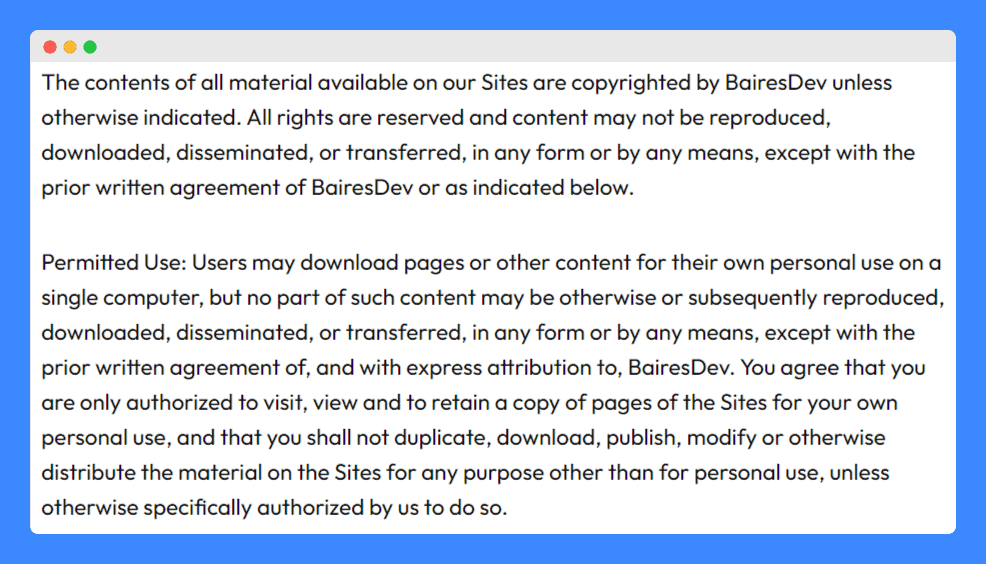
This is an excellent example of a copyright disclaimer because it effectively demonstrates an understanding of copyright law and its application to digital content.
By clearly outlining permitted and prohibited uses, BairesDev establishes a strong foundation for protecting its software and content.
4. Edpuzzle
Edpuzzle is an online platform that allows educators to create and share interactive video lessons. As an educational institution and content creator, Edpuzzle heavily relies on intellectual property to deliver its services.
Here’s a snippet of its intellectual property disclaimer:
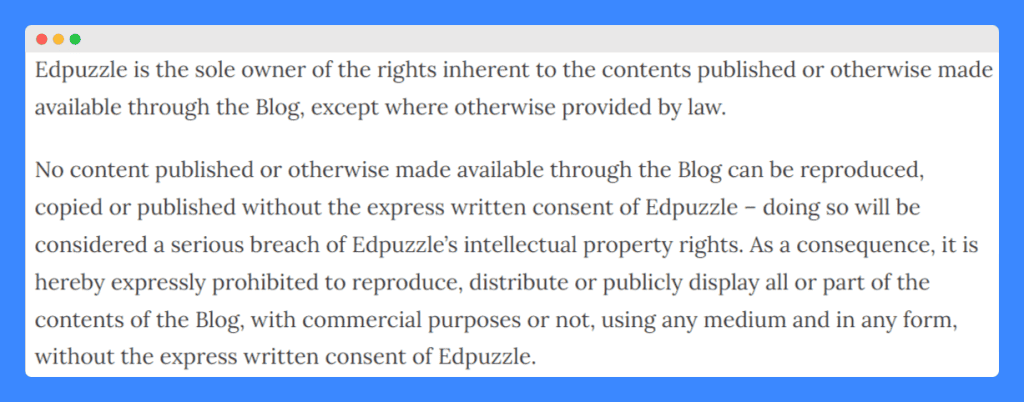
This comprehensive approach, coupled with a strong warning about the consequences of infringement, effectively safeguards Edpuzzle’s intellectual property. This makes it a prime example of how educational institutions can protect their valuable content online.
5. Miranda Kelton
Photographer Miranda Kelton’s website disclaimer, located within her Terms of Use page, showcases a unique approach.

While it doesn’t explicitly outline limitations on use or reserve rights, it emphasizes respect for intellectual property and outlines consequences for infringement. What’s more, it provides a clear process for reporting copyright violations.
This demonstrates an understanding of the broader legal landscape surrounding intellectual property and highlights the importance of responsible use.
Sample Intellectual Property Disclaimer Template
This sample intellectual property disclaimer template is intended as an initial framework for developing your own disclaimer for your website.
While it covers the basic elements, it’s essential to adapt and refine the content to match your particular circumstances and address any specific legal considerations.
Take your time to personalize the disclaimer to ensure it fully aligns with your unique needs and provides the necessary legal protection.
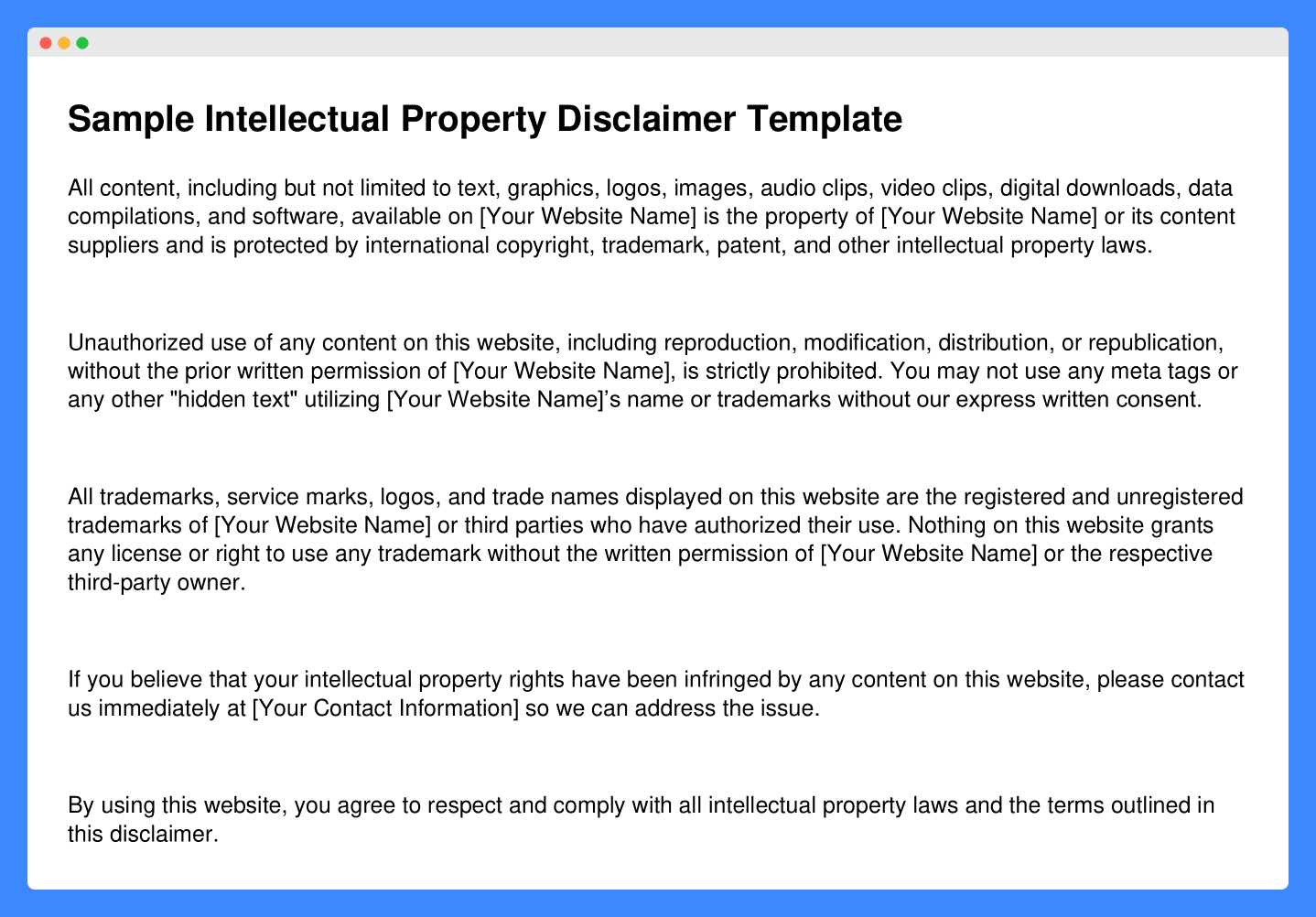
Frequently Asked Questions
Do I need different intellectual property disclaimers for my website and products?
Yes, you may need different disclaimers for your website and products to address specific rights and usage terms for each. Tailoring them ensures comprehensive protection.
Should I include an intellectual property disclaimer in my Terms of Service?
Yes, including an intellectual property disclaimer in your Terms of Service is advisable. It clarifies usage rights and enhances legal protection.
How often should I update my intellectual property disclaimer?
Update your intellectual property disclaimer regularly, especially as laws change or when you introduce new content or services.
Can an intellectual property disclaimer prevent unauthorized use of my logos and trademarks?
An intellectual property disclaimer can deter unauthorized use by clearly stating rights, but it cannot prevent all infringements alone.
Is an intellectual property disclaimer legally binding?
Any legal disclaimer, including an intellectual property disclaimer, is generally legally binding if properly drafted and displayed.



